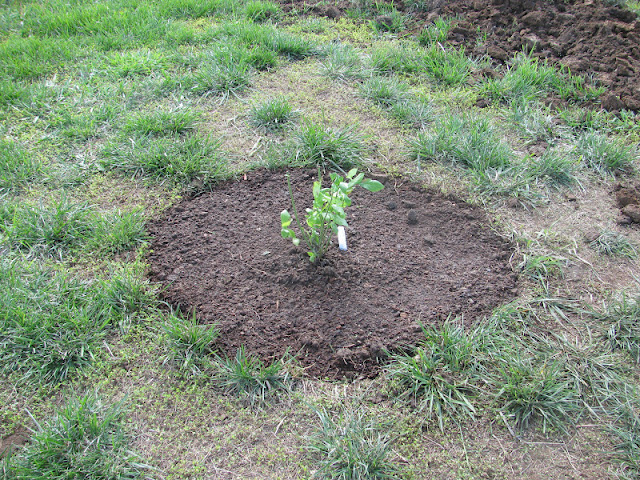We had the honor of having members of the Kansas Permaculture Collaborative over for two "permablitzes" on our farm over the past couple of weekends. We had people drive in from as far away as Salina and Kansas City to help us complete a swale building project for our food forest. I can't describe how thankful and humbled I feel after the outpouring of help and comraderie. Permaculture people are good people.
 |
| The southwest edge of our property will be devoted to a food forest planted around a hugelkulture bed and two swales. Excess water from the swales will be diverted to the duck and goose pond |
We enlisted the help of Steve Moring of Vajra Farm LLC in developing a plan for our property. I have read about permaculture for years but felt like I lacked the experience needed for planning the water catchment systems in particular. Steve's help has been invaluable for putting my ideas into practical action.
 |
| The main plant elements on the plan. This does not list the many varieties of berries, herbs, flowers, etc. that will be planted around the larger trees. |
Like everyone else on the planet, we are on a budget. We can only afford to put part of the plan into action this year, so we thought it was smart to get started on the swales and food forest.
First, a little terminology. To quote this excellent overview, swales are "water-harvesting ditches, built on the contour of a landscape." Our orchard area is located at the bottom of a slope and swales slow water down as it moves through our property. Slowing the water down gives it a chance to soak in and do the work we want it to do: watering our trees and filling up our new duck pond.
The first step was to get a laser transit and to find the level contours along the hillside.
 |
| They are hard to see, but the orange flags mark out two swales running through our existing orchard. |
We marked off the contours for two swales running through the orchard as well as a hugelkulture bed (more on that later) near the house.
We set out the swale lines in February and two months later had our first permablitz event. We shoveled out a thick carpet of wood chips five feet across and topped it off with a blanket of manure.
 |
| These swales didn't seem so long until we had to cover them with woodchips and manure! |
 |
| Swales still going... |
 |
| ...all the way to the west edge of our property |
Once we had the wood chips and manure laid out, it was time to get heavy equipment involved. We hired a contractor to come and dig out a trench 6 inches deep and five feet across and mound it over the top of the woodchips/manure swale line. He also dug out the duck pond and installed pipes underground to link the swales with the pond. When the swales fill with water after a large rain event, the excess water will be diverted to the pond.
 |
| The north swale |
The following weekend we had our second permablitz. We had a fellow with a tractor till up the swale berms to remove the largest chunks. We also spread gypsum to help break up our heavy (heavy!!) clay soil as well as another hefty helping of manure. Then we sprinkled a cover crop (peas, vetch, lentils,etc.) over the top before rolling aged prairie hay over the top for mulch.
 |
| So thankful for friends to help us with this huge task! |
We did not buy all of the trees for the food forest this year; trees are expensive! I hope to complete the main plantings this fall and next spring. The last thing we accomplished on the permablitz day was to plant the trees I did have along the berms.
 |
| One of the Chinese Chestnuts |
That was one full day!
 |
| Swale doin' its thing |
We got over half an inch of rain that night and got to see the swale system in action the next day.
 |
| The pond slowly starting to fill in |
Still to do:
 |
| Hugelkulture bed-to-be |
We have nitrogen-fixing plants (false indigo [amorpha fruticosa], seaberry, goumi, and brushy clover [lespedeza bicolor] and comfrey to plant throughout the food forest area.
Lastly (I think), I need to sow red clover on and around the pond berm. Lots of progress and lots to keep us busy.
Note: Some links included in this post are affiliate links. Click here to read our disclosure statement.







